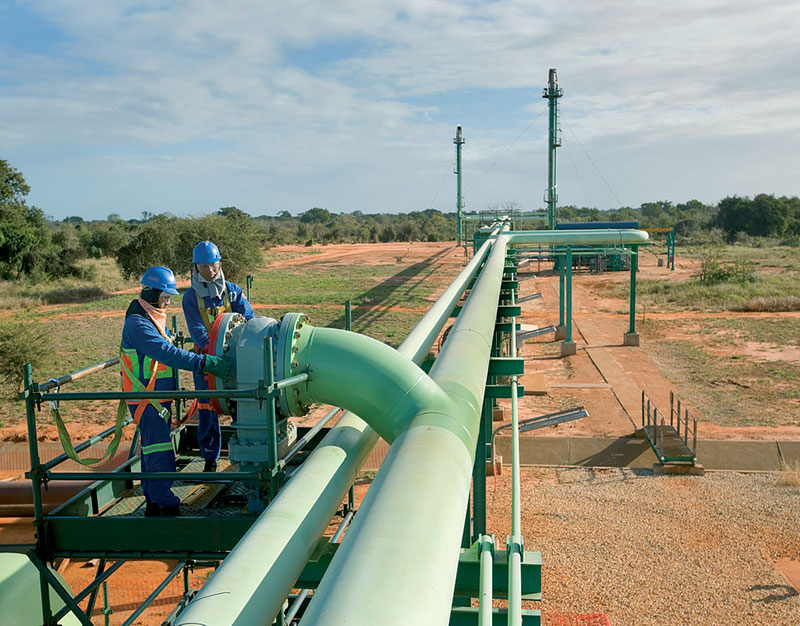May 2022, Vol. 249, No. 5
Features
Renewable Natural Gas: Pipe Dream or Industry Future?

By Richard Nemec, P&GJ Contributing Editor
After several decades of being a favorite of the environmental community, natural gas finds itself amid climate change worries on the outside looking in, seeking to make billions of dollars of pipeline, processing and storage infrastructure relevant in a world hungry for a carbon-free energy future by 2050. In 2022, it’s not easy being green in the gas industry.
The outcry to take gas out of the residential, commercial and industrial sectors, including power generation, has grown louder as activist groups and editorial writers increasingly advocate for electrification based on electricity produced from solar and wind. They no longer heed the warnings about overreliance on renewables for making electricity.
Now more of a mainstay in balanced energy planning, renewable natural gas (RNG), or biomethane, with longer-term transitioning to carbon-free hydrogen, is offered by the fossil fuel industry as a way to fuel a long-term transition to net-zero carbon in the energy space while making use of the existing energy infrastructure to support continued economic growth.
Skeptics argue the industry is just trying to hang on to its markets; they refuse to see the merits of cutting carbon emissions faster and at less cost as gas industry advocates maintain.
As a counter to the skeptics, the American Gas Association’s (AGA) current Chair Kim Greene, CEO of Southern Company Gas, and AGA CEO Karen Harbert released a new study outlining a vision of “Net-Zero Emissions Opportunities for Gas Utilities,” advocating a national approach that they contend can “leverage the unique advantages of gas technologies and distribution infrastructure.”
The two gas advocates offered several pathways that the study had modeled as a range of options to be applied nationally and on regional, state and local levels.
“Climate change is a defining challenge across the globe, and this industry and natural gas are part of the solution,” Greene emphasizes.
Early this year, AGA indicated 2021 RNG capacity in the United States as nearly 74 million BTUs, or 870 million gallons of ethanol gallon equivalent (EGE). AGA counted 176 RNG production facilities with another 220 under construction or planned. The agricultural sector is leading the way in plants under construction. Production facilities vary in size, from 300 million to 1 billion BTUs, to more than 600 billion BTUs.
Also in February, the Federal Energy Regulatory Commission (FERC) issued natural gas policy statements, including one on greenhouse gas (GHG) emissions, to provide more legal cover against challenges to its future decisions approving new gas infrastructure projects.
FERC characterized its latest move on gas matters as providing “legal durability” to future decisions. It is another move in the governmental sector that reflects the growing need for the U.S. energy sector to decarbonize, which is what is driving the increased interest in options such as RNG.
Global Debate
The debate is global in nature, as developments in February this year underscore. A subsidiary of Brisbane, Australia-based Energy Developments Pty. Ltd. (EDL) inked a series of agreements with the U.S. Appalachian midstream units of UGI Energy Services LLC and Williams Companies to acquire RNG supplies from the American companies for use in its downstream U.S. markets. The supplier, Pennant Midstream LLC, is part of a partnership between UGI and Williams units. RNG is slated to flow to EDL in 2023.
Similarly, the Norway-based oil and gas giant, Equinor ASA, has released a bullish projection for the decarbonization of the gas industry in Europe, touting its still-robust North Sea supplies as a hedge against uncertainty over Russia’s future deliveries, given the Ukraine situation and other looming issues.
On an earnings conference call in February, Equinor CEO Anders Opedal indicated that “stable and reliable deliveries” of gas from Norway promise to be a key for Europe this year and beyond. As part of the mix, Opedal indicated that “renewables and low-carbon solutions” will be needed for Europe to achieve its net-zero targets.
Like in the United States and elsewhere, Europe energy consumers are showing growing long-term interest in hydrogen and carbon capture, utilization and storage (CCUS), Opedal pointed out. And the catalyst for moving in that direction beyond 2050 is greater use of RNG in the next three decades, industry analysts said. Along with other measures, RNG can help decarbonize the gas stream.
Focused on more intently in recent years, RNG is a pipeline-quality gas that is considered fully interchangeable with conventional natural gas and thus can be used in natural gas vehicles (NGV). RNG is essentially biogas (the gaseous product of the decomposition of organic matter) that has been processed to purity standards.
Like conventional natural gas, RNG can be used as a transportation fuel in the form of compressed natural gas (CNG) or liquefied natural gas (LNG). There are also bio-LNG and “certified natural gas” as low-carbon alternatives. RNG qualifies as an advanced biofuel under the federal renewable fuel standard.
Biomethane refers to biogas that has also been cleaned and conditioned to remove or reduce non-methane elements. Biogas is produced from various biomass sources (landfills, livestock and wastewater treatment) through a biochemical process, such as anaerobic digestion or thermochemical means (gasification). Biogas, with little cleanup, can generate electricity and heat and is used as a replacement for traditional natural gas to generate combined electricity and heating for power plants.
At a national conference last December, officials in the Sacramento, Calif.-based RNG Coalition projected that there will be up to 1,000 RNG production facilities by 2030, a four-fold increase over current national totals.
One of the coalition’s recent reports estimates there will be 1.34 billion gasoline gallon equivalents (GGE) of demand for natural gas transportation fuel by 2025, most of which could be satisfied with RNG. The latest U.S. Energy Information Administration (EIA) annual energy outlook report was more bullish on the transportation demand given a “significantly higher” economic activity rebound that occurred in 2021.
NGVAmerica CEO Daniel Gage said his Washington, D.C.-based natural gas transportation trade organization remains “very bullish” about RNG, although in mid-February he was still awaiting the group’s latest accounting of 2021 growth in use of the fuel.
“Our members have made a serious commitment to move to 100% RNG, dispensing 80% RNG by 2030 and 100% by 2050,” said Gage, who was planning a webinar on RNG motor fuel availability for early March. In 2020, RNG replaced conventional natural gas as the nation’s dominant on-road NGV fuel source, he said.
“As long as we have life and organic matter on Planet Earth, we will have an unlimited supply of RNG to capture and repurpose/consume,” Gage said. “RNG is the most sustainable motor fuel in use today, achieving a carbon-negative result. No other fueling option can make that claim now.”
In the third quarter last year, the California Air Resources Board (CARB) confirmed that the energy-weighted carbon intensity (CI) value of the state’s RNG vehicle fuel portfolio is below zero (-62 grams of carbon dioxide equivalent per megajoule [gCO2e/MJ]). It calculated a negative CI for the past five reporting quarters, according to CARB.
One of the nation’s leading NGV fuel suppliers, California-based Clean Energy Fuels Corp., expects to have 194 million GGE of RNG supplies spread around 34 states in 2022, according to CEO Andrew Littlefair. In five years, Littlefair sees that total increasing to 474 million GGE in 2026.
Units of the global energy giants Total SA and BP plc have investments of more than $1 billion in Clean Energy’s RNG development and use of existing pipelines, including $650 million, plus pipelines, from BP and $400 million, plus pipelines, from Total Energies. Over the past five years, RNG growth in the transportation fuel market has been 267%, according to NGVAmerica.
Proponents for moving away from gas-fired energy, however, argue that further investment in the natural gas sector is akin to creating stranded investments because electrification is the only way to eliminate climate-driven GHG emissions.
Electrification advocates stress that every credible study on deep decarbonization agrees on the basics of a strategy to get there by 2050 as outlined in the Paris agreement, and the key to the strategy is greening the power grid, which is currently responsible for 28% of U.S. GHG emissions. They call for the rapid transition to zero-carbon sources like renewables, hydro and nuclear electricity sources.
Electrification buffs discount RNG as allegedly not being low-carbon and carrying local air and water impacts concentrated in vulnerable communities. Even if it were low-carbon and equitable, they argue, there simply isn’t enough of it to substitute for more than a small fraction of natural gas.
California is often the poster child for advocates on both sides of the RNG debate. As the most populous state and one with aggressive climate change and decarbonization goals, electrification proponents, including strong environmental group support, eye California as a bellwether.
And the nation’s largest natural gas distribution utility, Sempra’s Southern California Gas Co. (SoCalGas), has launched a long-term effort to flow 20% of its gas stream with RNG by 2030 and be net-zero in its total system by 2050 with an assist from hydrogen blended into its extensive transmission and distribution pipeline system.
Clean Solutions
“Our mission is to build the cleanest, safest and most innovative energy company in America,” said Scott Drury, SoCalGas CEO, in announcing the climate initiative last year. “We will lead the energy transition by providing clean fuels and innovative technologies essential to carbon neutrality for California. Through collaboration and partnership, California can develop clean energy solutions at scale and serve as a global beacon for energy innovation.” Opponents point to natural gas demand statistics in the state and nationally that dwarf the current respective volumes of RNG.
At the end of 2021, the RNG Coalition released a study that concluded the renewable gas sector could become a sizable green economic engine. It estimated that RNG would contribute 22,600 jobs, $2.6 billion in gross domestic product (GDP) and $5.4 billion in total business sales for operations and capital expenditures in 2021.
The coalition study cites work by the International Energy Agency (IEA) estimating global impacts as part of its net-zero-by-2050 scenario of 5,310 new RNG production facilities by 2050, which could create an estimated 806,248 jobs. If, however, RNG reaches total buildout under a more aggressive initiative, IEA estimates it could result in 43,000 facilities by 2050, which would create an estimated 6.5 million jobs.
Argonne National Laboratory maintains a national database that tracks operating, under construction and planned RNG production facilities, coming from landfills, organic waste and wastewater treatment facilities. Landfills are the third-largest source of human-related methane emissions in the United States, according to the U.S. Environmental Protection Agency (EPA).
With landfill gas (LFG), the digestion process takes place underground rather than in an anaerobic digester. As of September 2021, there were 548 operational LFG projects in the United States, according to the EPA. Most of these projects use biogas to produce electricity.
Dairy and farm animals are an expanding source of RNG production. Animal manure is collected and delivered to anaerobic digesters to cut methane emissions. The resulting biogas can be processed into RNG and used to fuel NGVs or produce electricity. In the recent past, there have been more than 250 anerobic digesters operating at commercial livestock farms; most of these facilities use biogas for electricity generation.
AGA noted that in 2021 70 livestock-based programs were producing RNG, with another 105 under construction. A few farms are using biogas to produce transportation fuel, including ones in California and Indiana.
While organic waste and landfills provide sizable portions of RNG, municipal solid waste is the dominant source. Last year, the U.S. produced a total of 74 trillion BTUs of biomethane with 75% of that total coming from municipal solid waste plants.
Long recognized, biogas can be produced by digesting the solids removed in the wastewater treatment process. According to EPA estimates, this biogas potential is about 1 cubic foot of digester gas per 100 gallons of wastewater.
Energy generated at 1,300 of today’s 16,000 U.S. wastewater treatment plants could potentially meet 12% of the national electricity demand, according to a study by three national water organizations (National Association of Clean Water Agencies, the Water Environment Research Foundation and the Water Environment Federation). This could spur some production of RNG.
More than half of the 1,300 energy-producing plants make use of their biogas on-site; many others produce RNG for off-site uses. Among all of the plants, the wastewater treatment facilities have smaller energy-producing capabilities with only two equipped to produce more than 600 billion BTUs, while most of the municipal solid waste facilities exceed 600 billion BTUs.
Proponents of keeping gas in the mix of tools used to decarbonize U.S. energy said there are complementary options to RNG such as hydrogen and even bio-LNG and certified natural gas. Late in 2021, three Dutch companies reported being on track to produce bio-LNG for use in maritime transportation starting in 2023.
Under a partnership among Attero, Nordsol and Titan LNG, a production facility in the Netherlands is expected to produce 2,400 tons annually of LNG from biogas. RNG produced from decomposed organic matter will be liquefied and cut GHG emissions from ships compared to their conventional fuels. The European Union is funding part of the development of the bio-LNG project.
Similarly in the United Kingdom, a nonprofit technology foundation, MiQ (Methane Intelligence) is dedicated to developing reduced methane solutions for the oil/gas sector.
“MiQ’s mission is to reduce impact from oil and gas methane emissions until we have an entirely renewable energy supply,” said Rory Grenham, a London-based spokesperson for the foundation. “MiQ creates incentives for the drastic reduction of methane emissions by delivering a thriving market for certified natural gas. It has developed a gas certification system, allowing the fuel to be “credibly certified” based on its methane emissions performance, Grenham said.
According to Grenham, MiQ currently is certifying 10 Bcf/d (283 MMcm/d) of the world’s gas supply, or about 2.5% of the global gas market. “They’re working with some of the world’s biggest producers, such as ExxonMobil, BP, EQT and Chesapeake with many more in the pipeline,” he said.
When gas is “certified,” it generally has been verified by an independent third party to have been produced in a manner consistent with certain environmental, social and governance (ESG) standards. Those doing the certifying say that methane emissions have emerged as a key performance metric for certified gas, with an emphasis on monitoring and measurement.
All this adds up to the fact that the gas business, from production, midstream to distribution, is changing rapidly in the face of unprecedented forces—natural, social and political. Operators may need a lot of new and old skills to manage the transformation.
Richard Nemec is a regular contributing editor to P&GJ. He can be reached at rnemec@ca.rr.com.







Comments